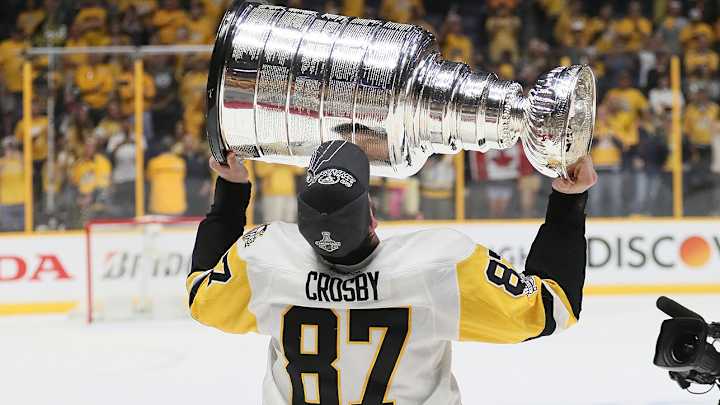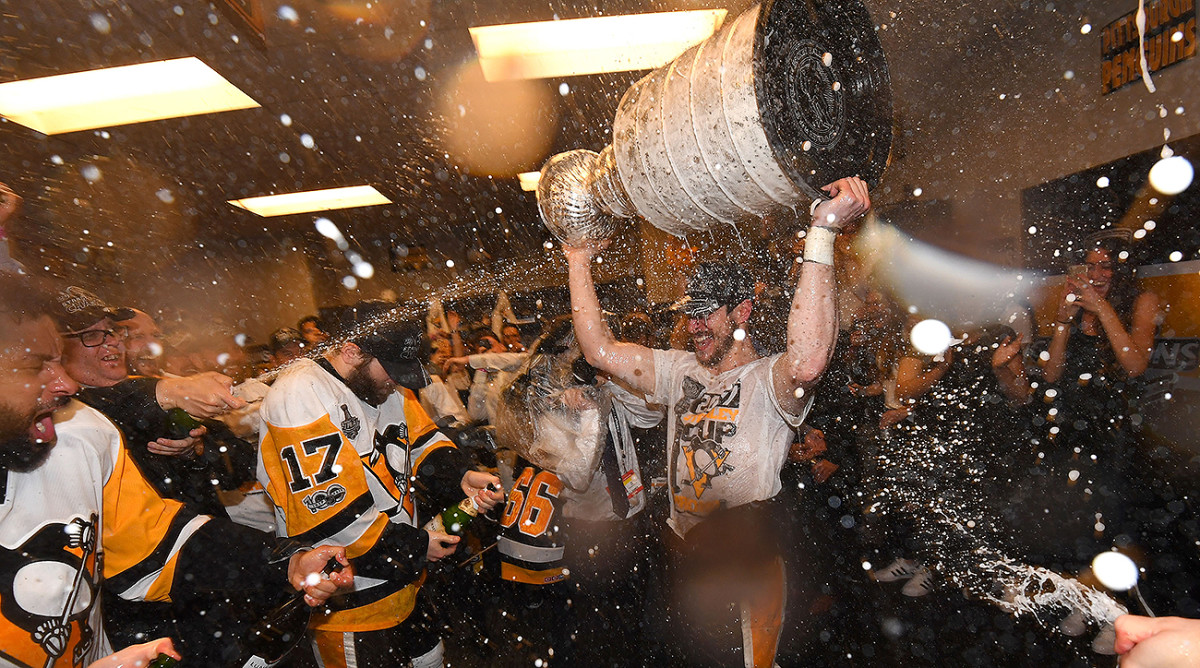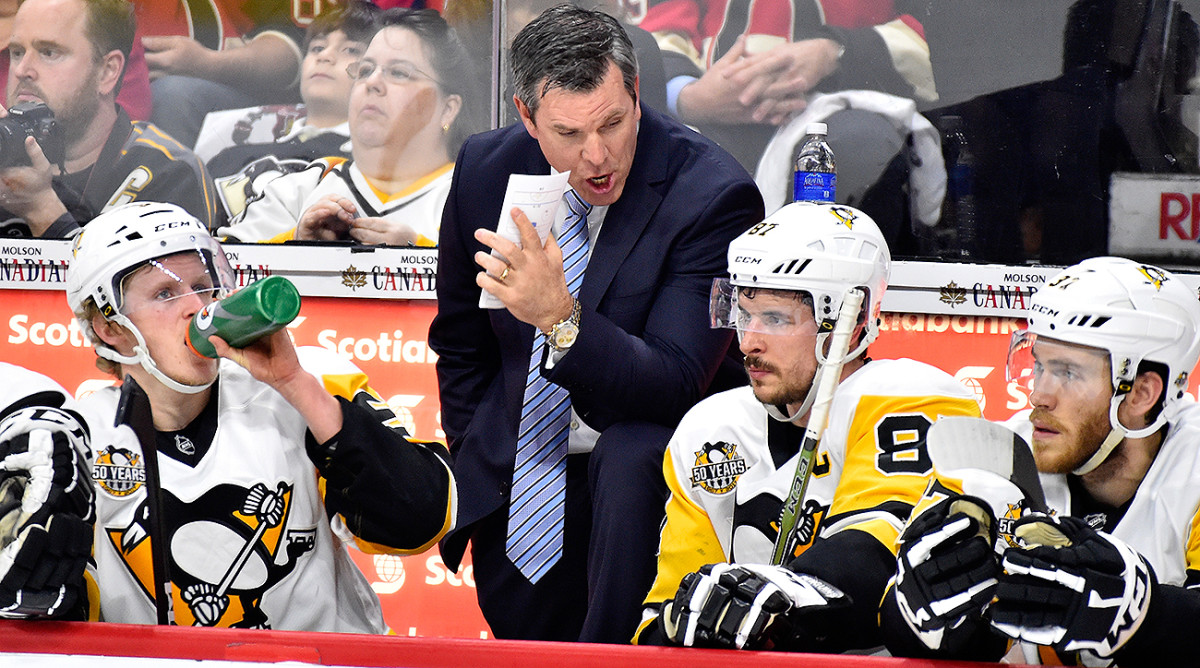Sidney Crosby and the Penguins proved their mettle on the long road to a Stanley Cup repeat

Out from the locker room emerges Sidney Crosby, victory hat tugged taut, gripping a T-shirt soaked in Coors Light and champagne. There’s a slight limp in each step as he walks down the empty hallway in Nashville, toward the bus bound for another Penguins after-party. Then he stops. Turns. Looks back, but just for a moment. “It’s hard to believe we found a way to do it,” Crosby says. “We talked about it all year, but it was such a steep climb to get here.”
The summit had been waiting for him. Three-hundred and sixty-four days earlier, amid the 2016 Stanley Cup celebrations in San Jose, Crosby found Andy O’Brien, his longtime trainer, and firmly told him, “We’re not done. We’re going to get another.” At the time O’Brien wasn’t surprised by the proclamation, “because he always says that, whether after the Olympics or the playoffs or any kind of success. It’s always, ‘Let’s do it again.’ ”
And now, as Sunday night morphs into Monday morning at Bridgestone Arena, as so many disappointed souls stumble out of downtown honky-tonks, everything was coming true. After outlasting the feisty Predators 2–0 in Game 6 of the Cup finals, the Pens became the NHL’s first repeat champs of the 21st century. Their captain, Crosby, earned his second straight Conn Smythe Trophy, becoming just the third player to accomplish that feat. And with it he enters the conversation for hockey’s Mount Rushmore—provided there’s room on the batholith to chisel beside the heads of Wayne Gretzky, Bobby Orr, Gordie Howe and Crosby’s boss, Penguins co-owner Mario Lemieux.
• Congratulations, Penguins fans! Get your Stanley Cup champions gear here
“He was already heading there, and eventually he would’ve gotten into that conversation,” Pittsburgh general manager Jim Rutherford says. “But we can start talking about it, as of June 11.”
“He’s done everything he could possibly do as a player,” Hall of Fame coach Scotty Bowman says.
“One of the best all-time,” Lemieux says. “Among the greats of our game.”
Though he would never admit it, the 29-year-old Crosby undoubtedly understands where he ranks among the elite. “A constant student of his environment,” his agent, Pat Brisson, says. Crosby grew up in Nova Scotia, which meant cheering for the Canadiens, but kid Sid revered Red Wings center Steve Yzerman, the last captain to oversee consecutive Cup runs. During Penguins road trips earlier in his career, Crosby would devour Yzerman’s biography. “He was studying his role by looking up to the top,” Brisson says. “He wouldn’t come out and say, ‘I’ll be the best ever, I’ll be this or that,’ but in his mind he was starving for it, he was hungry for it.”
Still, no amount of reading could prepare Crosby to handle what his idol encountered with Detroit in 1997 and ’98—or what Lemieux faced while guiding Pittsburgh to the ’91 and ’92 Cups. “The hardest part is that you can’t understand it until you go through it,” Crosby says.
Penguins stars from their first back-to-back title teams look back 25 years later
Not that Crosby seemed burdened by this latest journey. He sustained a concussion against the top-seeded Capitals during the Eastern Conference semis but missed only one game. “Yeah,” he says, sighing with relief, “really happy that it wasn’t anything long-term.” The Senators provided a steady diet of physical punishment in the third round—not to mention some mid-action dousing with a water bottle from their bench—but Crosby nonetheless finished the series with six points, including the primary helper on Chris Kunitz’s goal in double overtime of Game 7. “We could’ve been out easily in the second round, third round,” he says. “It could’ve been different.”
Instead, his powers only seemed to strengthen during the finals, particularly after Nashville star P.K. Subban fibbed to reporters that Crosby had remarked on the defenseman’s bad breath during Game 3. (The actual conversation between Subban and Crosby, picked up by some hot mikes, contained mostly a run-of-the-mill swapping of f-bombs.) With three assists in Game 5, a 6–0 blowout at home, Crosby moved into a tie for fourth all-time with 56 career multipoint playoff outings, while also taking liberties of his own—namely smothering Subban’s head into the ice.
Three days later, returning to Music City with a 3–2 series advantage, Crosby took a power nap on the short flight. Upon waking up, he found himself looking around the cabin, peeking at the card games, taking stock of teammates on their final road trip of the season.
There was Patric Hornqvist, the Swedish forward who would bank the championship-clinching shot off goalie Pekka Rinne’s left shoulder with 1:35 left. And goalie Matt Murray, who would win his second Cup with a 123-minute shutout streak that spanned Games 5 and 6. And winger Jake Guentzel, who would tie the NHL’s rookie playoff scoring record with 21 points while riding shotgun to Crosby.
“A lot of different things [went] through my mind,” the captain says. He shuffles farther down the Bridgestone hallway, pausing every so often to thank another well-wisher. It’s almost 1 a.m. The bus is waiting. “Thinking about a great opportunity, and being excited, and just trying to soak everything in.”
Moments of reflection are nothing new. Having trained Crosby since he was an apple-cheeked 13-year-old, O’Brien was hired as Pittsburgh’s director of sport science and performance in July 2015. The months that followed marked perhaps the toughest stretch of Crosby’s career, certainly since suffering two concussions in 2010–11. His offensive output sagged. Coach Mike Johnston was fired that December, replaced by minor league call-up Mike Sullivan. Where consecutive conference titles in ’08 and ’09 once sparked talk of a dynasty—a 21-year-old Crosby hoisting the Cup in the latter season served as the primary flint—the Penguins were suddenly facing outside questions about their star’s future.
“I remember him really being affected by all the things that were going on,” O’Brien says. “But he’s always got that positive spin on things. He said, ‘Maybe this is the adversity that needs to happen for something amazing to come around.’ ”
SI’s best photos from Game 6 of the Stanley Cup finals

No cheering may be the first rule of the press box, but an exception could be granted for the bushy-bearded gentleman in seat 64 at PPG Paints Arena. With a medical boot hugging his broken left tibia, Nick Bonino seemed anxious at the start of Game 5, leaning forward with his head bowed and hands clasped. But the Penguins center (nicknamed Bones) had no reason to feel rattled. From the very first shift—when Crosby split Nashville defensemen Ryan Ellis and Roman Josi, drew a holding penalty and hit the post while falling down—it was clear that Pittsburgh remained in safe hands down below.
Twelve months ago Bonino had been anchoring wingers Carl Hagelin and Phil Kessel on Pittsburgh’s HBK line, a trio so toothsome that it inspired a sandwich stuffed with ham, bacon and kielbasa at the local establishment Primanti Bros. Bonino’s presence in the press box was a reminder that—like Charles Barkley, who crashed a presser before Game 4 in Nashville to preach the virtues of playoff hockey—the Penguins know how to rebound. No Bonino, shelved after blocking a Subban shot in Game 2? No Kris Letang, the minutes-gobbling defenseman who needed neck surgery on April 13 to repair a herniated disc? No problem.
On the one hand, these injuries were mere speed bumps compared with what other Cup repeaters have had to overcome. In November 1991, Penguins coach “Badger” Bob Johnson died from brain cancer. Six days after the Red Wings won the ’97 Cup, the drunk driver of a limousine carrying three members of the organization hit a tree, leaving two of the passengers—defenseman Vladimir Konstantinov and team masseuse Sergei Mnatsakanov—critically injured. “Terrible, terrible tragedies,” recalls Bowman, who took over in Pittsburgh when Johnson fell ill and similarly steered Detroit through its glory years. Yet even Bowman says that, at least on the ice, “We also didn’t have the same grind as the Penguins are going through right now.”
Consider: Sunday marked Pittsburgh’s 213th game since the start of the 2015–16 season, an enervating total that doesn’t even include last September’s World Cup of Hockey, in which seven Penguins competed and Crosby (who else?) won MVP for Team Canada. “I might be sleeping for about a week now after this,” defenseman Ian Cole says. “We’ll see if I make it to the parade or not.”
A first-round win over Columbus might have seemed breezy on paper, but the Penguins were steadily outshot throughout the series and needed 49 saves from goalie Marc-André Fleury in the clincher. “I thought we played really well against them,” laments Blue Jackets coach John Tortorella. “Their quick-strike offense just capitalized.”
If not issuing an outright rebuttal to the value of attempting shots in bulk—Pittsburgh ranked 15th out of the 16 playoff teams in five-on-five shot attempt percentage—the Penguins proved that opportunism can prevail. Nashville never recovered after allowing three goals in 4:11 during the first period of Game 1. The third period of Game 2 brought an even swifter shelling—strikes from Guentzel, forward Scott Wilson and center Evgeni Malkin spanning 3:18. As Sullivan texted Tortorella, a close friend, “We’re ugly, but we find a way.”
Sullivan, a Marshfield, Mass., native, never sugarcoated hard truths after replacing the laissez-faire Johnston. Cameras once even captured Sullivan telling his players to “shut the f‑‑‑ up” on the bench last year. “To step in and set the standard for how it’s going to be, that was huge,” Tortorella says. “That’s who Mike is. He’s secure in his skin, but he also has a humbleness that attracts players to him.”
No doubt this mettle helped when, for the second straight postseason, Sullivan passed over the 32-year-old Fleury in favor of the 23-year-old Murray. Made midway through the Ottawa series, the decision might have opened rifts on less sturdy teams. But after Murray posted a playoff-high .937 save percentage in 10 starts, it was Fleury who passed him the Cup on the ice in Nashville. “He’s been such a mentor for me,” Murray told NHL Network, fighting back tears. “That was huge.”
And when Sullivan asked an unheralded blue line, arguably the weakest on a Cup champion since the Hurricanes’ in 2006, to pick up the slack for Letang, they responded. “A simple bunch,” Sullivan says. “They understand where their limitations are.” Translation: The likes of Hainsey and Cole weren’t driving play like Nashville’s blueliners, but their hot-potato approach to flipping pucks from the defensive zone allowed for brisk enough breakouts. “Everybody pretty much wrote us off, saying we didn’t have a chance without Kris,” says Cole, “and understandably so.”
Indeed, as an Eastern Conference head coach framed his doubts, “I wasn’t sure how far [Sullivan] would get with that back end, but look at them now.”

Yes, look at them now.
Look at Hagelin, who won a footrace to pot an empty-netter with 14 seconds left on Sunday, cranking out celebratory pull-ups on a bar in the hallway while still wearing his skates after the Cup-clinching victory. And a shirtless Bonino, injected with painkillers for the occasion, hobbling around on crutches. And Malkin and Kessel dousing each other with champagne, as if the Brut bottles were Super Soakers and the locker room their front lawn.
See Sullivan work the room with his 79-year-old father, George, congratulating everyone in sight. Listen to Kunitz croon an NHL-themed lullaby as he lugs the silver chalice to the bus:
And down will come Stanley, cradle and all. . . .
The Predators, meanwhile, struggled to put their magical season to bed. In advancing beyond the second round for the first time, they had exposed the wider world to their own brand of fandom: booming soccer-style chants and an affinity for hurling catfish. The official club of country music, they lured celebrity anthem singers like Martina McBride and Faith Hill, while tens of thousands of fans, sardined on Broadway, watched Luke Bryan perform atop Tootsie’s Orchid Lounge before Game 6.
And yet everything fell apart from the sharp blast of a whistle on Sunday. Sixty-seven seconds into the second period Nashville’s leading scorer, Filip Forsberg, sneaked a short-side wrister through Murray’s armpit. Just as center Colton Sissons jammed the loose puck into an open net, referee Kevin Pollock, from an obstructed angle, blew the play dead. Though karma eventually returned to the Preds in the form of three power plays, Sissons’s nongoal was their best chance; they finished the series without scoring over the final 123:23.
With a Hall-of-Fame resume, Tom Barrasso deserves enshrinement
As he rode the freight elevator from his box after the Cup presentation ceremony, misty eyes fixed ahead, Nashville GM David Poile could at least take solace in a bright future. A handful of restricted free agents, most notably No. 1 center Ryan Johansen, who missed the finals after undergoing emergency thigh surgery, need new contracts. Otherwise, Nashville can comfortably bring back a similar lineup and challenge again.
And the potential for a Penguins three-peat? That hasn’t happened since the Islanders snatched four straight in the early 1980s, more than two decades before the salary cap ushered in the age of parity. But who would dare doubt Crosby and Malkin, Murray and Sullivan now?
“It’s been a lot of hockey these years,” Crosby says. (Sixty-nine hours and 44 minutes of personal ice time since the start of 2015–16, to be exact.) He’s reached the loading dock, stopping to sign autographs for a few fans in Predators gear. “Might take a little bit of extra time to get some rest. But when you have this feeling fresh in your mind, there’s always a ton of motivation. Just the fact that you’re chasing something keeps you in it.”
Be it hockey history, or simply the bus bound for another party.
